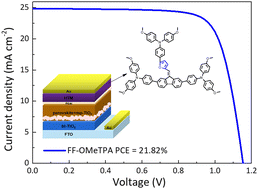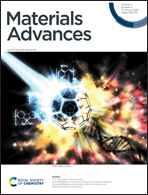Efficient furan-bridged dibenzofulvene-triphenylamine hole transporting materials for perovskite solar cells†
Abstract
Inspired by the superior properties of dibenzofulvene-triphenylamine hole transporting materials (HTMs), a rationally designed type of HTM with furan as the side-arm bridge has been synthesized, namely, FF-OMeTPA. A dibenzofulvene-triphenylamine HTM with thiophene as the side-arm bridge (FT-OMeTPA) is also prepared. The effect of heteroatomic sulfur-to-oxygen change on the molecular and photovoltaic properties in perovskite solar cells was investigated. The experimental and theoretical results illustrate that the furan-based molecule has better conjugation than the thiophene-based one, leading to higher hole mobility. The PSC employing oxygen-containing FF-OMeTPA delivered a power conversion efficiency (PCE) of 21.82%, whereas the FT-OMeTPA-based PSC exhibited a lower PCE of 18.01%. Significantly, the FF-OMeTPA-based devices also outperform those employing conventional spiro-OMeTAD. In addition, the studied molecules exhibit comparable device stability and much lower synthesis cost than spiro-OMeTAD.



 Please wait while we load your content...
Please wait while we load your content...